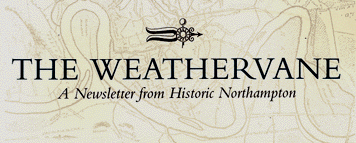

|


Weathervane Newsletter Summer 1997

Landscape Archives Presented to Smith College
A series of events on March 7th marked the presentation to Smith College by Historic Northampton of archival documents associated with the landscape and gardens of the property surrounding the present residence of the president of Smith.
The Kneeland Garden Archives, named for the family that once resided on the property, include garden journals, plans, photographs, nursery bills and drawings from the period 1881 to 1917. Now on the Kneeland garden site is the building that was built in 1920 as a home for William Allan Neilson, Smith's third president. It continues to be the official residence of the President of the college.
Ceremonies began at 4:30 in the Smith College Archives, with the presentation of the landscape archives to Ruth Simmons, President of Smith, by Kerry Buckley, director of Historic Northampton. "As we pass these documents along," said Buckley, "we, as members of the Northampton community and the Smith College community, commemorate a shared legacy in this history of a place and we celebrate the stewardship of those at Smith who preserve this legacy... for all of us to enjoy." The documents, which had been donated to Historic Northampton by members of the Kneeland family, will now reside in the Smith College Archives.
Following the presentation of the archives, John Burk, Gates Professor of Biological Sciences, presented a lecture, "The Kneeland Garden: Neighbors and Allies." An informal reception at the Lyman Plant House, where the spring bulb show was illuminated, followed at 6 P.M.
According to Kim Tripp, director of Smith's Botanic Garden, the Kneeland material provides "an excellent tool for interpreting and managing the landscape, gardens and natural areas in relation to historical precedent and to ecological changes that have occurred since the journals and documents were recorded. This is an exceptional record of a garden of its period and [can be seen as] symbolic of the relationship of the community and college as historically and currently intertwined with landscape and environs of Northampton and the Valley."
Contents Historic Northampton.